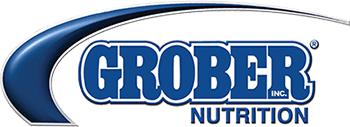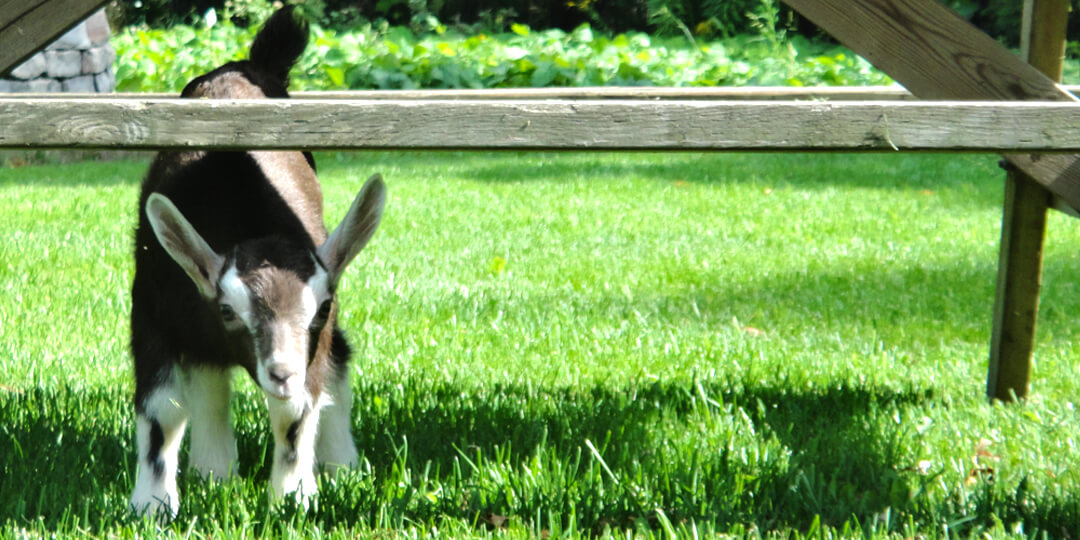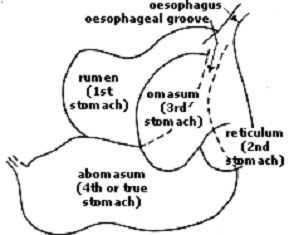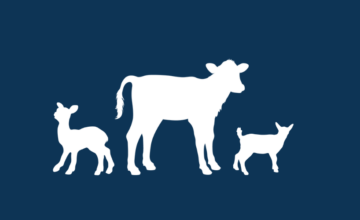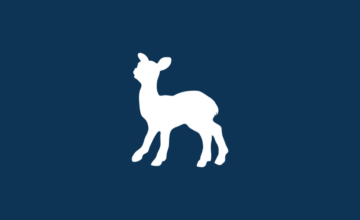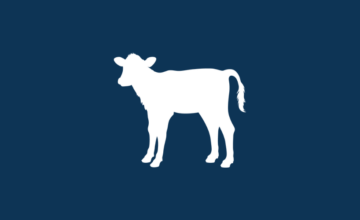A Review of Kid Goat Nutrition
- Feb 21, 2011
- By Grober Nutrition
- In Canada, USA
Describing the pre-ruminant At birth, kid-goats are not yet functioning ruminants – the rumen develops over time. The newborn kid-goat has an omasum and abomasum that comprises 70% of their digestive system compared to the adult goat where the rumen and reticulum make u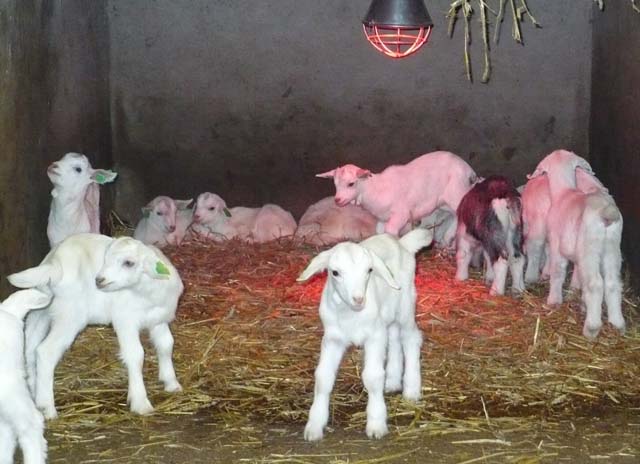 p 70% of their digestive system (Figure 1). At birth, they have difficulty digesting sugars/starches until the rumen develops. They do have the digestive enzymes to break down lactose, the naturally occurring sugar in milk.
p 70% of their digestive system (Figure 1). At birth, they have difficulty digesting sugars/starches until the rumen develops. They do have the digestive enzymes to break down lactose, the naturally occurring sugar in milk.
The esophageal groove is a reflexive tube that runs from the esophagus into the abomasum. This reflex is stimulated by sucking enabling the animal to drink milk or milk replacer, and have it pass directly to the abomasum for digestion. Nipple feeding further encourages this reflex to remain in place. If milk by-passes to the rumen, it will ferment causing digestive upset in the animal. Repeated tube feedings will disrupt this reflex causing milk to pour into the rumen. This is not uncommon and can be characterized by unexplained pasty diarrhea. Through the addition of forage and grain, a bacterial population will start to develop in the rumen. The bacteria break down fibrous materials making the nutrients from these feedstuffs available to the animal. Encouraging rumen development will allow kids to wean with ease and continue to grow well after milk has been removed.
Developing your feeding program
Kids need colostrum (first milk). The timing, quality and source are important to ensuring that an immune response occurs protecting them against early environmental diseases. Kids should receive 150-200 mL of colostrum within 90 minutes of birth. Kids weighing 3-3.5 kg at birth should have a total colostrum intake of 600 mL over 24 hrs. A typical rule of thumb is to ensure that kids get 4 g of IgG/kg of bodyweight. IgG (immunoglobulin) is one of the proteins found in colostrum necessary for generating successful passive immunity transfer. Sheep colostrum has been found in several studies to be a poor choice for colostrum; cow colostrum is more recommended however the risk of disease transfer is high. Colostrum replacer is a good option for kids, the pasteurization process allows for a break in disease transfer (eg CAEV and Johnes). Headstart HiCal ® Kid colostrum replacer available through Grober, is specifically formulated for immunity, energy and mineral profile for kid goats. A high quality milk replacer is an important kid rearing tool for raising orphan kids, multiple kids, to prevent the spread of disease and to ensure the milk is consistent at each meal. Milk ingredients provide the most digestible food source to kids. The key to using a milk replacer successfully is ensuring that it is thoroughly mixed. Leaving undissolved clumps can cause digestive upset and deter kids from wanting to drink. When properly mixed, milk replacers enable the kid to receive a consistent amount of calories and nutrients. Most importantly, using a milk replacer allows for a break in disease such as Caprine Arthritic Encephalitis virus (CAEV) and Johne’s Disease which can be spread by infected colostrum and milk.
Bloat in kids Bloat is a common problem in young pre-ruminants. Bloat is an overproduction of gas caused by organisms (not necessarily pathogenic) in the rumen or abomasum. This can be caused by non-feed material in the abomasum and poor rumen development leading to quick growth of microbes that produce excessive gas. Bloat can occur at any age under the right conditions such as irregular feeding times, too much time between feedings, and inconsistent mixing of milk replacer. Too much time between feedings generates low pH in the true stomach for long periods of time. The pH remains steadier when animals have access to milk more often. Bloat can also be c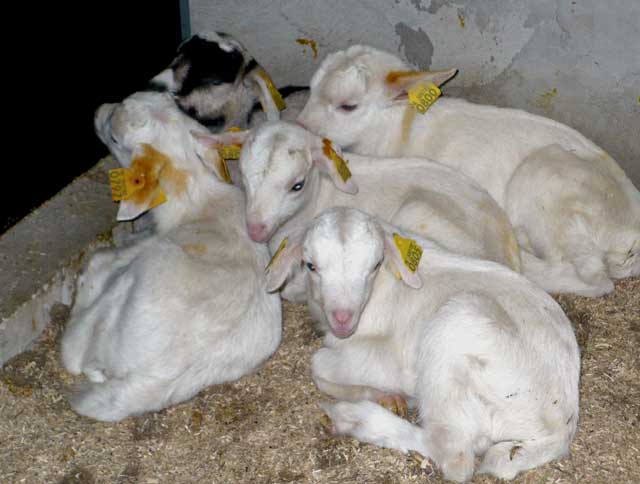 aused by certain bacteria, which are able to multiply rapidly under the right set of conditions. One of the factors that allow for these bacteria to grow is a low pH (2-3). This pH range is common in animals that have not eaten in a long while or are fed less frequently. This type of bloat has a quick onset and a quick death and is most common in animals less than 2 months.
aused by certain bacteria, which are able to multiply rapidly under the right set of conditions. One of the factors that allow for these bacteria to grow is a low pH (2-3). This pH range is common in animals that have not eaten in a long while or are fed less frequently. This type of bloat has a quick onset and a quick death and is most common in animals less than 2 months.
Feeding Management Tips
1. Milk Replacer intake
- a. Up to 1 Litre/day the first week mixing at a rate of 150g/L.
- b. 1.0-1.5 Litres/day thereafter aiming for an average daily gain of 140-250 g/d.
2. Kids will eat starter/creep feeds by about 1 week old and begin ruminating around 2 weeks old. Kids should be offered roughage (creep feed and/or hay) and unlimited water.
Cold milk feeding: this practice allows for kids to drink smaller meals frequently when the milk is fed at 20°C. By spreading their feeding over a longer period of time this gives young kids time to digest. This is not recommended for newly born kids.
Automatic feeding machines: allows for small amounts of warm milk to be made and available to kids at all times. Regular maintenance is required, including cleaning and calibrating.
Acidified milk feeding: Some on-farm work has shown that the addition of organic acid, primarily formic acid, helps reduce the bacterial load in the milk when left available to allow for free-access feeding. Care must be taken not to over acidify the milk; too much acid may also cause digestive upset. The careful handling of acid is always recommended to avoid injuries to people or other animals.
Weaning: Weight at weaning is more important than age, it is also important that the kid is consuming solid feed regularly. Weaning may be initiated when the kid has reached 2.5 times their birth weight and is eating 250 g of solid feed/day.
Grober Nutrition
Recent Posts
Tags
Archives
- October 2024
- July 2024
- May 2024
- April 2024
- January 2024
- December 2023
- October 2023
- September 2023
- August 2023
- June 2023
- December 2022
- November 2022
- October 2022
- August 2022
- July 2022
- June 2022
- May 2022
- April 2022
- March 2022
- February 2022
- January 2022
- August 2021
- February 2021
- September 2020
- June 2020
- April 2020
- May 2017
- April 2017
- October 2016
- September 2016
- August 2016
- March 2016
- March 2015
- January 2015
- December 2014
- December 2013
- September 2013
- May 2013
- January 2013
- December 2012
- November 2012
- March 2012
- March 2011
- February 2011
- November 2010
- August 2010
- December 2009
- November 2009
- March 2009

